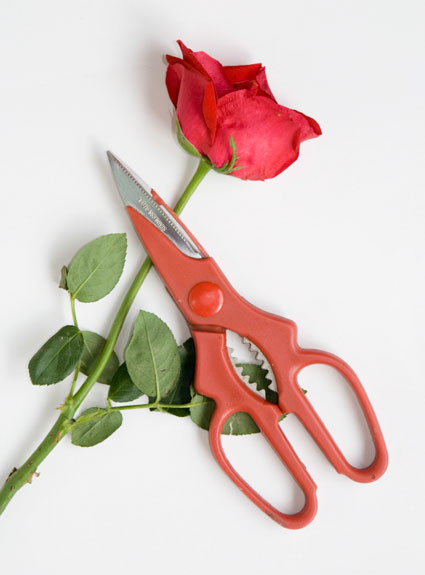DE-FLOWERED
Posted by Deirdre | Filed under Blog
Some women buy Prada. I buy peonies by the arm full, a habit I developed when, in the bloom of youth, I lived in Paris. There, the streets are full of flowers for sale and the citizens buy them daily.
I used to marvel at the extravagance. After all, flowers die, so there is always a need to replace them. Therein, though, lies their beauty; they are caprice in a vase.

Back in Toronto, I tried to recreate my vie en rose by buying buds weekly at the flower shops along Avenue Road. It was, however, short-lived, as my posies inevitably looked pooped. No amount of bending, plucking or spritzing could save them from wilting. I felt like nature’s freak, the tulips bowing their heads in shame.
That’s why I jumped at local florist Karina Lemke’s recent invitation to attend a kind of Bouquet Boot Camp for not-so-green-thumbs like me.
Lemke is the genial host of Petal Pushers, the HGTV show that follows the florist and her team of designers as they complete all sorts of projects. As owner of the popular Posies flower store on trendy King Street West, she has created arrangements for clients that include Elton John, Bill Clinton, Justin Timberlake and Cher.
On the day of my crash course, I make a beeline over to where she is holding court in a downtown restaurant, buckets of spring blooms at her feet.
When it comes to flower arranging, she has one basic rule: “Make sure that the imperfect flowers Mother Nature hands you look perfect when you put them into a vase.” In other words, make art, not messes.
To get us going, Lemke hands out a brown paper bag filled with basic tools of the trade, including a small, sharp knife, hand-sized pruners and a roll of skinny florist tape that we have to cut into strips for placing lengthwise and crosswise at the mouth of the vase, creating a grid that keeps the flowers from flopping over.
To camouflage this grid, she urges us to “green it up” – that is, fill our vases with foliage that has been stripped of leaves that fall below the waterline (where they rot and form bacteria) and trimmed to an appropriate length (about five to seven inches above the lip of the vase).
Colour follows in the form of odd-numbered blooms (mostly threes and fives) chosen for their vibrancy and pretty scents. According to Lemke, “the trend right now is away from multi-hued, multi-floral arrangements. Using large, bountiful amounts of one type or shade is hip at the moment.”
As accompaniments to the colourful flowers, green-hued blooms like green tea roses or mint-toned cymbidum orchids add texture without being overwhelming, she says. Green snowball viburnum and mini green hydrangeas are also fresh and mix well with the white, yellow and orange flowers that rank among her favourites.
Although expensive floral arrangements are one of the first treats that homeowners give up during tough times, Lemke says people need not forego the luxury of flowers, even now. For a recession-friendly option, she advises going minimalist with one striking bloom in a bud vase: “Make it a statement flower, such as an orchid bloom or a single perfect tulip.”
Now that flowering season is upon us, she also cites “flowering branches such as forsythia, apple, peach, cherry or quince” as handsome and economical seasonal picks. “Many people have these species in their gardens or can purchase them inexpensively from florists and garden centres.”
All of this conversation flows as discarded leaves hit the floor. On the subject of greenery, Lemke likes salal and gardenia leaves for the depth of their colour. Both are on hand during our class, as is aspadestra, which we pin into curls for a modernist touch.
Having made her arrangement – a posy comprising pink roses, purple lysianthus and gold cymbidium orchids – earlier, Lemke walks around the room examining ours. Apparently, structured is also in these days, because she frowns when she comes to mine. “Yours is wilder, not as contained,” she says diplomatically.
Maybe, but I am still pleased. My hyacinths are perky, my aspadestra is proud. Finally, my cut flowers aren’t bowing their heads in shame any more, but raising them in triumph.
Pointers for buildingthe perfect bouquet:
• When purchasing flowers, pick out those with the brightest tones, as these are usually the freshest, florist Karina Lemke advises. Also, she says, give their stems a sniff. “If they stink, it means that they have been sitting in murky water. Put them back and try another bucket.”
• Once you get the flowers home, cut their stems on the diagonal to the desired height and remove any leaves that may fall under the waterline. Use the powdered floral food that you get with the flowers, as it helps to kill the bacteria that cause them to age prematurely. A drop of bleach or a dash of gin or ginger ale will also do.
• Keep arrangements away from heat sources and direct sunlight to prevent them from wilting. Replenish the water frequently, as flowers such as tulips and hyacinths can drink a lot over a single day.
• Keep flowers away from fresh fruit, Lemke stresses. Fruit produces ethylene gas, which causes blooms to perish quicker.
